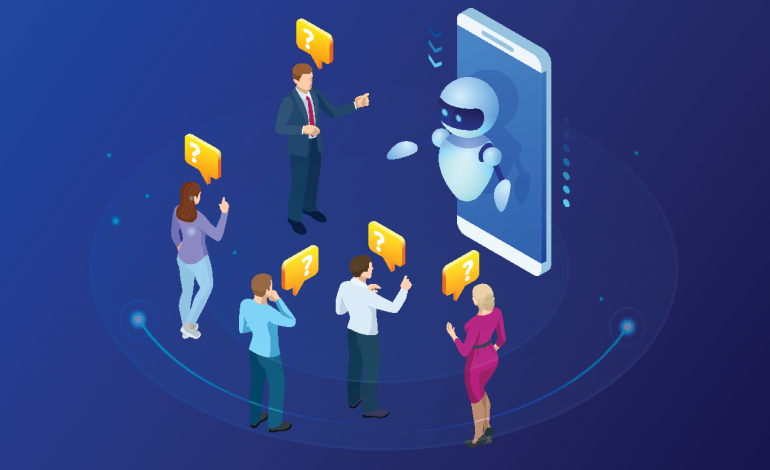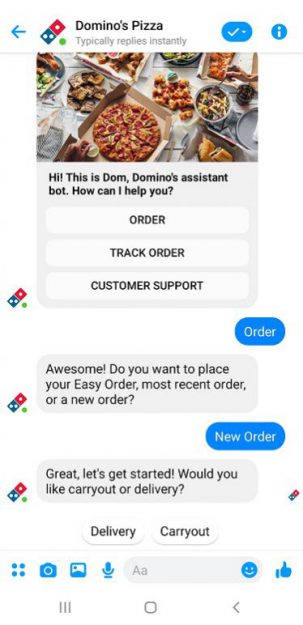
The web is in the middle of a chat bot revolution, with the market poised to grow “from $2.6 billion in 2019 to $9.4 billion by 2024” according to Business Insider. And the technology powering chat bot software has advanced significantly in recent years, with bots of varying complexity appearing all over the internet. Popular sites and services like Twitch and Discord have introduced many users to the concept of bots in their role providing moderation and automated features in chat, but chat bots can be programmed to do much more.
Using pre-written responses, user-directed training, and the power of AI, chat bots can enhance the functionality of almost any website. Bots are capable of “conversational” customer support and sales, and provide the kind of immediate response that produces the best customer experience. They’re growing in popularity in just about every industry, from business services to ecommerce. In this guide we’ll explain how chat bots work, how they can help businesses, and how you can easily add one to your site via a live chat plugin or app.
Quickly jump around this post with this index:
At the most basic level, a chat bot provides automated responses to user input via a chat interface. Moderation bots in Twitch chats can auto-ban commenters who post offensive material, for example, or tell you the name of the song playing in the background when you alert them with a message like “!nowplaying.”
More advanced forms of chat bots can communicate with users via natural language, and when used for business purposes can be an example of “conversational commerce.” Website visitors often encounter chat bots performing customer support roles online, or offering button-based menus in a chat interface that replicates the experience of selecting options via a phone menu. AI-based chat bots can provide humanlike responses to a wide variety of customer questions, using the power of artificial intelligence to match customer input to appropriate replies.
A major part of the appeal of chat bots is that language is such a natural way to interact with a business. As Matt Schlicht of Chatbots Magazine explains:
“Language is the most natural interface humans understand, and that’s the interface that bots use. Instead of needing to constantly learn visual interfaces, bots will enable us to naturally use language, the first interface we were ever taught.”
We couldn’t have put it better ourselves! And with a service like Formilla it’s easier than ever before to add a chat bot plugin to your WordPress site or your Shopify store.
There are two distinct types of chat bots commonly used online today, and the two types function a little differently. Menu-based chat bots use visible options to guide site visitors through a pre-set series of choices and functions. AI-based chat bots use natural language processing to interpret conversational input from users and return suitable responses. In both cases chat bots usually interact with customers via a chat widget on your site (typically found in the lower right corner of your page).

Also known as “rule-based” or “button-based” chat bots, these bots often function similarly to the customer service phone menus we encounter when calling a business. Menu-based bots like Formilla’s Custom Chat Bots can blur the line between a “chat” and an “interface.” Some might display visible “buttons” for users to click in order to be directed to the right part of your site or routed to the right live chat department. Others ask users to type in what they are looking for, usually selecting from a small list of predefined options.
More advanced forms of menu-based chat bots can integrate seamlessly with other features on your site, such as displaying a calendar to allow visitors to schedule a product demonstration or popping up a menu to allow shopping within the chat interface itself.
Menu-based chat bots usually aren’t very complex. Site owners will define the key options to be displayed, and set the appropriate responses to each of those options in the “tree.” If a business already has a phone-based customer service menu set up, then it’s usually easy to see how to translate that selection of options and sub-options into a rule-based chat bot interface.
These chat bots are straightforward to update and maintain, since the possible paths and functions are clear “under the hood” for site administrators, and can be adjusted as needed. These kinds of bots are also good at marketing to site visitors, since a visible menu of options can make visitors aware of products and services that they didn’t previously know about.
Lastly, menu-based chat bots are great for automated lead generation and pre-qualifying potential leads from site visitors. Bots can gather contact information from visitors, determine what kind of product or service they are looking for, and populate your lead database or similar CRM software with useful data.

AI-based chat bots use principles including machine learning and natural language processing to provide intelligent responses to user input – and to get smarter over time. Formilla’s Helper Chat Bots are an example of AI bots in action. Site owners create chat bots by entering a number of anticipated customer questions (and natural language variations of those questions), and then pre-writing an appropriate response for the bot to deliver. The bots can then be deployed on sites as part of a live chat platform, and artificial intelligence will help the chat bots “understand” a huge variety of different ways visitors might phrase common questions.
The next important part of how AI chat bots work is training. Artificial intelligence isn’t perfect, but it can get better over time. When it comes to Formilla’s Helper Chat Bots, site owners help their bots improve by reviewing transcripts of their interactions with site visitors. When a bot is unable to provide an answer to a customer query, or responds incorrectly to something a visitor says in chat, this is an opportunity to correct and improve the chat bot via “training.” The more chat bot training you do, the more accurate and comprehensive the bot’s responses will become over time.
In contrast to the simplicity of menu-based chat bots, AI chat bots harness the power of conversational commerce to provide a more natural and human experience for site visitors. These bots are good at helping visitors who don’t know what they are looking for to find their way around your site, since they can handle a much wider variety of user inputs and questions than menu-based bots. AI chat bots also feel more “personal” than menu-based options, and when used well they can improve the efficiency of your on-site customer support and sales efforts and upgrade the overall customer experience you offer.
You can check out our results for an in-depth look at how we trained and improved a Formilla chat bot.
Read more about different types of chat bots.
The uses of chat bots on business websites are varied, but can be broadly categorized into customer service, marketing, and sales tasks. Chat bots can be most effective when they’re part of a full live chat and marketing automation platform, as this kind of integration allows for the greatest efficiency. Automated chat bots can staff the live chat feature on your site when human agents aren’t available, or can help screen incoming visitors and direct them to the right department for further assistance.
In our modern world of infinite distractions, every passing moment a site visitor isn’t adequately engaged with your business is a chance for them to be lost forever. This is where chat bots really excel, as they can provide an easy path from first arriving on a site to exactly the information, product, or service that is needed.
 As previously discussed, menu-based chat bots can often function in the same way as automated phone menus in order to provide general customer service and support. Customers who know what they need from your company can find it through the chat menu, quickly reaching the information they need or being routed to a live chat customer support agent for further assistance.
As previously discussed, menu-based chat bots can often function in the same way as automated phone menus in order to provide general customer service and support. Customers who know what they need from your company can find it through the chat menu, quickly reaching the information they need or being routed to a live chat customer support agent for further assistance.
AI-based conversational chat bots can be used to answer common customer questions and lower the workload for your live chat agents. This makes customer service chat bots an especially appealing option for small businesses and others looking for increased efficiency. Proper training and natural language processing allows AI bots to understand customer support questions even if they are phrased in a specific way the bot has never encountered before. If you notice that you’re getting dozens of live chat queries per day asking for your physical business hours or what kind of shipping options you offer, you’ll save time and money in the long run by setting up a Helper Chat Bot to provide those answers.
One of the most frustrating experiences a customer can encounter is waiting on hold on the phone when they need customer service. And as documented in a 2020 Washington Post article, those wait times only got worse in 2020 as coronavirus disrupted established routines. But with a chat bot customer support system, there is no need to wait on hold. Customers can begin interacting immediately, exploring self-service options right away. Even if their specific issue is too complex to resolve until a live support agent can get involved, the fact that they can start taking action and getting information immediately with a chat bot provides for a more satisfying customer experience than just waiting on hold.
 Chat bots can be a highly effective marketing tool, and are becoming increasingly popular with marketing directors looking to modernize their strategies. Chat bots are easy to update as business priorities change, so they can be adjusted to call out new products or features or let site visitors know about limited-time promotions. And at a time when many online consumers have tuned out elements like banner ads, bots can be a more effective way to communicate information to your visitors.
Chat bots can be a highly effective marketing tool, and are becoming increasingly popular with marketing directors looking to modernize their strategies. Chat bots are easy to update as business priorities change, so they can be adjusted to call out new products or features or let site visitors know about limited-time promotions. And at a time when many online consumers have tuned out elements like banner ads, bots can be a more effective way to communicate information to your visitors.
Chat bots are an example of marketing automation, and become more powerful when they’re part of a suite of marketing services (such as those offered by Formilla) and integrated with your CRM software. An AI chat bot that knows whether the person it is speaking to is an existing customer, a promising lead, or a first-time visitor can be designed to respond accordingly. Chat bots can also be set up to automatically adjust based on information like a visitor’s country of origin, delivering marketing messages in the appropriate language for an international visitor.
According to the marketing agency Red Bamboo, the most important digital marketing performance metric is return on investment, because that’s how you determine if what you’re doing digitally is working at all. And a small investment in chat bot marketing techniques can be a great way to improve your overall ROI, since chat bots can operate 24/7, handling many customers at once, usually without an increase in associated costs.
Most of what you’ll need to “spend” for a chat bot goes into initial setup and ongoing training time, along with service fees for platforms like Formilla (which are usually much less than the cost of paying developers to maintain the bots in-house). The chat bot on our own page at Formilla.com answers about 35% of all questions our customers have – and that 35% can gradually improve with ongoing training, providing even greater efficiency and cost effectiveness. And as your business grows and scales up, the cost of your chat bots doesn’t need to increase, which means that your automated marketing activities can serve more visitors for the same price.
Even if a marketing chat bot only increased your on-site conversion rate by 1%, it could quickly pay for itself in terms of ROI because of the relatively low investment required. And since data from Gartner indicates that implementing AI can actually increase conversion rates by up to 30%, it’s easy to see why this is potentially such a cost-effective and appealing technique for digital marketers.
Gartner data indicates implementing AI (such as chat bots) on your site can increase conversion rates by up to 30%. Click To Tweet
As Red Bamboo says: “Your website should be your number one salesperson.” Whether you have a WordPress site, a Shopify e-commerce store, or a B2B-focused service platform, your site is the most accessible and visible part of your company for your potential customers. And sales-focused chat bots are a great way to make your site more appealing and more effective at actually converting visitors into sales.
Chat bots can help throughout the sales funnel. When visitors arrive on your site for the first time, a conversational bot can provide basic information about your company in a friendly and natural way. Then sales-focused chat bots can help spark interest in your products or services, identifying visitor needs and showing them the offerings that are most likely to lead to conversions. And once the visitor has become an interested customer, live chat sales agents can answer any further questions they have and direct them through completing their purchase, making the whole experience as frictionless as possible.
Integrating with your existing customer data can make chat bots effective at up-selling and cross-selling. A returning customer to an ecommerce retailer can be told about products that might interest them based on their order history, for example. Or if your company offers software to enhance websites – like we do here at Formilla – you might want to use a chat bot to tell your existing customers about newly added features or options that you now provide. Sales-focused chat bots can also provide features that support your type of business specifically, such as allowing interested visitors to schedule product demonstrations with your sales team.

It is possible to create and maintain your own chat bot, but unless you’re especially interested in the programming and theory aspects of the process, it’s probably easier to just add one via a plugin service like Formilla. We make it easy to add live chat and chat bots to your existing website, whether you use WordPress, Shopify, Weebly, or a wide variety of additional content and ecommerce platforms.
To add a chat bot to your site using Formilla:
As documented in our article on chat bot training, your Helper Bot will get better and better over time if you train it based on its interactions with site visitors. After you’ve set it up with basic questions, all you need to do is regularly review the transcripts of its conversations, to find the places where its responses fell short. By broadening out the varied inputs that correspond to specific outputs, while also identifying entirely new needs your site visitors are expressing that can be fulfilled by newly written replies, your bot will grow more helpful and effective with each training session, increasing its efficiency and value to your organization.
With the Formilla platform you can enjoy a free trial of our AI-based chat bots on your site, along with the additional live chat and marketing automation features we offer. You can add a chat widget and get started today, and see for yourself the power of chat bots for customer support, marketing, sales, and the overall customer experience on your site.
Live Chat Vs. Chat Bots: Strengths, Weaknesses, and How to Use Them Together
Header image by mohamed Hassan from Pixabay
Today’s Must Reads